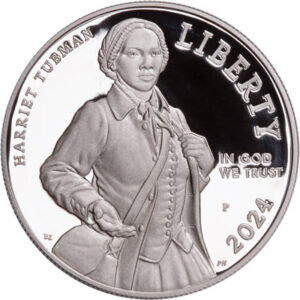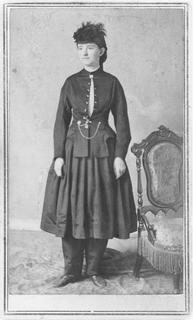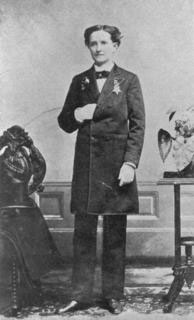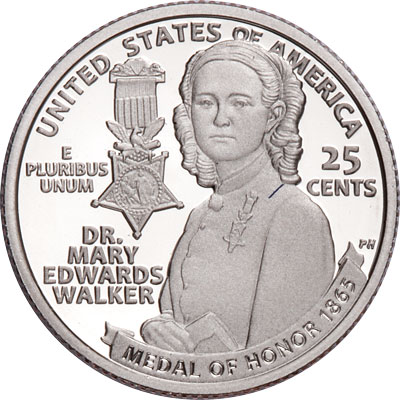The Mettle Behind the Medal

America started the 1800s bursting with the energy of a new nation. Each decade’s developments exceeded the ones before it. Business, politics, geography, culture – all pulsated with progress.
But with these changes, came huge social upheaval. The result? A reform movement took root. In addition to slavery, crusaders addressed suffrage, alcohol and – this came as a bit of surprise in my research – a call for more relaxed clothing for women!
In these swirling currents, Mary Edwards Walker was born to a large family of mostly girls to reform-minded farmers in Oswego, NY. A port on Lake Ontario, Oswego was an outlet for the extensive Erie Canal network. It also was a destination in central New York’s Underground Railroad.
Mary’s Medical Vita

Credit: From Library of Congress
Mary’s parents wanted their girls to have the same education as boys. They started a school. A self-taught physician, her father also instructed his daughters that corsets deformed the female body. Looser clothing not only gave them greater movement, but wearing trousers made it easier to do farm work, the family’s main source of income. Allowing women to wear relaxed clothing would become a national health crusade, thanks to reformist and newspaper editor Amelia Bloomer, of Seneca Falls, NY.
Mary graduated to a local prep school where the curriculum included courses on science and medicine. After teaching to earn money for tuition, she was able to enroll in Syracuse Medical College. In 1843, the 22-year-old earned her medical degree. And, in another sign of central New York’s growing influence in the anti-slavery movement, that same year abolitionist Fredrick Douglass spoke to a crowd of 500 in a Syracuse public park.
When the economic divide between northern and southern states triggered the Civil War, Mary moved to the nation’s capital in 1861. She volunteered her medical services for the Union Army, which had set up a hospital in the U.S. Patent Office. She next moved out to Virginia where she cared for wounded soldiers, then to Ohio where she was an Army surgeon.
In April of 1864, after crossing into enemy territory, she was captured by a sentry. Mary was held at Castle Thunder, a notorious military prison in Richmond, VA, before she was exchanged for a Confederate soldier.
After her release, Mary returned to the Midwest and served in the Louisville Women’s Prison Hospital in Kentucky. Later, she moved south to Clarksville, TN to an orphanage, caring for children who had lost their parents during the war.
In November of 1865, three months after the Civil War officially ended, and having left government service, Dr. Mary Edwards Walker became the first – and to date the only – woman awarded the Medal of Honor given to recognize U.S. military service.
Mary’s Political Vita

Credit: Courtesy National Library of Medicine
In the decades afterwards, Dr. Walker was active in the suffrage movement, always wearing her Medal of Honor. In 1871, she tried to register to vote, but was denied; the following year, suffragist Susan B. Anthony cast her ballot in the 1872 Presidential election in Rochester, NY, and was arrested. Well into that decade, Mary switched from bloomers to dressing in men’s more streamlined pants, with a top coat. On several occasions, she was arrested for impersonating a man.
After her father died in 1880, leaving the Oswego farm to her, Mary ran for the U.S. Senate. She lost. But by then, she had opened her childhood home to those who were also socially ostracized, harassed, and arrested for not conforming to traditional lifestyles.
In 1912 and 1914, she testified before the U.S. House of Representatives in support of women’s suffrage, again wearing her Medal of Honor.
Then, in 1917, the terms used to designate civilian eligibility for that award were reappraised, and Dr. Walker was stripped of her medal. In protest, she refused to surrender it, and continued to wear the medal for the rest of her life. On February 21, 1919, Dr. Walker died at the age of 87 and was buried in a black suit in the family plot in Rural Cemetery in Oswego.
Restoring Walker’s Recognition

Eighty years later and thanks to the efforts of her descendants and a subsequent Congressional reappraisal of her achievements, her Civil War contributions were re-acknowledged and her status restored.
In 2024, the U.S. Mint released into circulation a U.S. Womens Quarter to pay tribute to her groundbreaking achievements. Designed and sculpted by Medallic Artist Phebe Hemphill, the reverse features Dr. Walker holding her pocket surgical kit, with the Medal of Honor on her uniform, and surgeon’s pin at her collar.
Mary’s is the 13th quarter since the U.S. Mint launched this series to acknowledge women’s contributions to American history. Are you collecting them? For yourself or a young collector? You’re invited to share your experiences about collecting these quarters in the comments section below.
SOURCES:
Alexander, Kerri Lee, 2019-2019; updated by Rothberg, Emma Z., 2023. “Mary Edwards Walker 1832-1919.” https://www.womenshistory.org/education-resources/biographies/mary-edwards-walker
Freethought Trail. Walker, Mary Edwards 1832–1919. https://freethought-trail.org/profiles/profile:walker-mary-edwards
Lange, Katie. DoD News, Defense Media Activity. March 7, 2017. “Meet Dr. Mary Walker: The only female Medal of Honor recipient” https://www.army.mil/article/183800/meet_dr_mary_walker_the_only_female_medal_of_honor_recipient
National Park Service. “Dr. Mary Edwards Walker.” https://www.nps.gov/people/mary-walker.htm
Sutherland, Laurie. “Dr. Mary Edwards Walker: Women of the Mayflower series.” Mayflower Quarterly. 2010. https://digitalcommons.imsa.edu/cgi/viewcontent.cgi?article=1019&context=pres_pr
That History Nerd. “Damn, Girl-Mary Walker, Civil War Surgeon.” March 1, 2019 http://www.thathistorynerd.com/2019/03/damn-girl-mary-walker-civil-war-surgeon.html




A great bio capturing every facet of Mary Walker’s life! I started writing my bio about her during covid and realized one hidden point. She may not have become a good orator but she was convincing when she told women to “think for themselves, learn to listen and recognize their self-value.” Her philosophy and goals resonate with women today. I tried to echo them in “Destiny’s Daughter” now from Apprentice House Press.
Thanks for stopping by & for your comment. Dr. Walker certainly was an impressive woman!